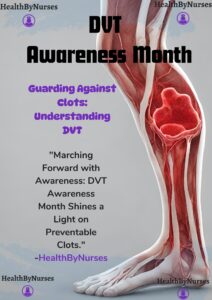As a nurse dedicated to patient care and advocacy, I am honored to contribute to DVT Awareness Month by sharing valuable information about Deep Vein Thrombosis (DVT). Throughout this month, it is my mission to raise awareness about DVT, its risk factors, symptoms, and prevention strategies.
Introduction:
 Firstly, let’s delve into what DVT is and why it’s important to be aware of it. Deep Vein Thrombosis occurs when a blood clot forms in one of the deep veins, typically in the legs. These clots can obstruct blood flow, leading to swelling, pain, and potentially life-threatening complications such as pulmonary embolism if they break loose and travel to the lungs.
Firstly, let’s delve into what DVT is and why it’s important to be aware of it. Deep Vein Thrombosis occurs when a blood clot forms in one of the deep veins, typically in the legs. These clots can obstruct blood flow, leading to swelling, pain, and potentially life-threatening complications such as pulmonary embolism if they break loose and travel to the lungs.
- DVT is a condition that affects millions worldwide and can have serious consequences if not detected and treated promptly.
- Deep Vein Thrombosis (DVT) and Pulmonary Embolism (PE) represent serious yet preventable medical conditions that frequently go undetected.
Definition :
DVT stands for Deep Vein Thrombosis. It is a medical condition characterized by the formation of blood clots (thrombi) within the deep veins of the body, typically in the lower legs. These clots can also develop in the thigh, pelvis, and arm.
Risk factors:
Understanding the risk factors associated with DVT is crucial for early detection and prevention. Factors associated with DVT are :
- Immobility
- Recent surgery
- Prolonged sitting during travel
- Pregnancy
- Smoking
- Obesity
- Certain medical conditions increase the likelihood of developing blood clots like Antiphospholipid syndrome, Behcet’s disease, Factor 5 Leiden mutation, Protein C / S deficiency, etc.
Signs and symptoms :
- Swelling
- Pain
- Tenderness
- Redness, or warmth in the affected limb
Prevention & Treatment:
Prevention is key in the fight against DVT: As a nurse, I emphasize the importance of lifestyle modifications such as regular exercise, staying hydrated, and avoiding prolonged periods of immobility.
- For individuals at higher risk, especially those undergoing surgery or hospitalization for medical conditions, preventive measures such as wearing compression stockings, application of sequential compression devices, or receiving anticoagulant medications may be recommended.
Treatment :
- The treatment of Deep Vein Thrombosis (DVT) typically involves anticoagulant medications to prevent the blood clot from growing larger and to reduce the risk of complications such as pulmonary embolism. Standard prescribed medications are anticoagulants that include heparin, low molecular weight heparin (LMWH), and warfarin; lately the direct oral anticoagulants such as apixaban, dabigatran, or rivaroxaban are more commonly used.
- Additionally, compression stockings may be recommended to help improve blood flow in the affected leg and reduce swelling.
- In certain situations, especially if there is a high risk of pulmonary embolism or if the DVT is extensive, thrombolytic therapy (clot-dissolving medications) or surgical/endovascular interventions to remove the clot may be considered.
- Treatment duration and approach depend on factors such as the extent and location of the clot, the patient’s overall health, and the risk of bleeding complications.
Lastly, I urge everyone to prioritize their vascular health and seek medical attention if they experience any symptoms of DVT or have concerns about their risk. Early detection and intervention can significantly improve outcomes and prevent potentially life-threatening complications.
In conclusion, DVT Awareness Month serves as a reminder of the importance of understanding and preventing this often-overlooked condition. Thank you for joining me and let’s continue to spread awareness and support those affected by DVT.
